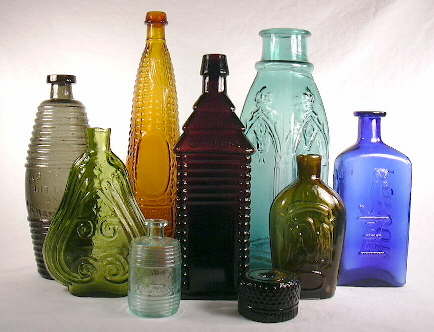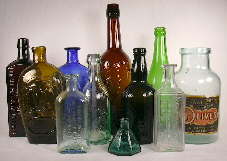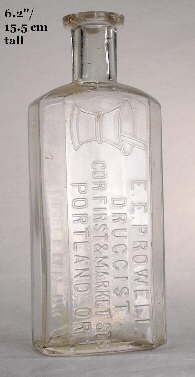HISTORIC BOTTLE
WEBSITE
USER TIPS
The following are some
items to consider or guide you in your use of the
Historic Glass Bottle
Identification & Information Website.
 1. Use the Main Subject Pages links
along the upper left side of each major "theme" page to move about
the pages.
1. Use the Main Subject Pages links
along the upper left side of each major "theme" page to move about
the pages.
2. For orientation, the major subject "theme" pages (e.g.,, Bottle Dating, Bottle Typing/Diagnostic Shapes) have a pale beige background; subordinate pages (like this page/box) have a darker tan background.
3. Near the top of every page on this site is a relative position or locater line with hot links that looks similar to the following example: HOME: FAQ's: Website map. This line shows how "deep" you are into a sequence of related pages and can be used to retrace your steps by clicking on the hyperlinks.
4. There is also a Website Map link at the bottom of the Main Subject Pages links bar. The Website Map is a "pop-up" page (see explanation below) that lists and has hyperlinks to every page within this website. Review that page to get a broad idea for what this website covers and contains.
5. One can also use the Back arrow on your browser to retrace your page moves. On both the Internet Explorer and Chrome browsers this is usually in the upper left hand portion of the screen below "File", though can vary depending on the custom settings a user has done on their browser. (Though if you know how to customize your browser, you undoubtedly know where the Back & Forward arrows are.)
 6.
Within all the website
pages are lots of hyperlinks (or simply "links") in the form of highlighted words,
phrases, and/or pictures. When clicked on, these hyperlinks will take you to related pages,
enlarged pictures,
definitions, and more. The necessity of presenting a lot information
and pictures utilizing a lot of links makes this website somewhat complicated;
the use of various glass making jargon also necessitates explanatory links.
When in doubt, use your browsers Back
arrow to retrace your steps.
6.
Within all the website
pages are lots of hyperlinks (or simply "links") in the form of highlighted words,
phrases, and/or pictures. When clicked on, these hyperlinks will take you to related pages,
enlarged pictures,
definitions, and more. The necessity of presenting a lot information
and pictures utilizing a lot of links makes this website somewhat complicated;
the use of various glass making jargon also necessitates explanatory links.
When in doubt, use your browsers Back
arrow to retrace your steps.
7. Be aware that clicking on most hyperlinks and images will result in a pop-up page. A pop-up page is a separate browser window which opens to show a user the selected page, information, definition or enlarged picture. The original page will be underneath the pop-up page. That a given hyperlink will result in a pop-up page will sometimes be noted, but generally not. The pop-up window must be closed (or diminished) to see the underlying page(s) Click HERE for an example although this Site User Tips page was likely accessed via a pop-up window. Note: Some browsers can be set to prohibit pop-up windows. For example, the search engine Google™ can be downloaded and incorporated into Internet Explorer and contains a pop-up blocking feature. Turn this feature off to view the pop-up pages.
8. Patience is necessary as many of these website pages are image rich and may take some time to fully load at slower internet speeds. A large majority of the imbedded pictures and illustrations have been minimized to some degree to facilitate page loading, though they are usually hyperlinked to larger, better quality versions for those interested. Although the extensive use of pictures slows down page loading, pictures are critical to the utility of this website and the proper presentation of information. Also be aware that the author of this site is well versed in bottle identification details but not so much with the nuances of web coding. So forgive the weird text and image location errors which various browsers or screen settings (or other reasons unknown to the author) make the appearance of any webpage awkward looking or non-symmetrical.
9. The information from this website is free to access and quote although we do request that the source be properly cited. Click HERE to go to the question on the Frequently Asked Questions (FAQ's) page which describes the suggested ways to cite this site in a publication or on another website.
10. The noted measurements on this site are sometimes in centimeters, sometimes in inches; volume is essentially always in ounces (or related capacities). This reflects a change in the way the author approached height and width measurements over the many years this website has been (and continues to be) worked on. He apologizes for that inconsistency. Click centimeters to inches conversion table for a table that makes the conversion easy.
 11. Be aware that the author of this site has much more experience with mouth-blown bottles (i.e.,
bottles made from the late 17th
century up until about 1920) than machine-made bottles. A user may find
that this site is skewed towards mouth-blown items, though there is a
plethora of information on machine-made bottles also. The author
believes that mouth-blown bottles are a much more complicated subject from the
perspective of the two primary goals of this website (dating & typology) than later machine-made items. As time goes and
more depth is added to this website, machine-made (and all) bottle information
has been and will continue to
also be expanded.
11. Be aware that the author of this site has much more experience with mouth-blown bottles (i.e.,
bottles made from the late 17th
century up until about 1920) than machine-made bottles. A user may find
that this site is skewed towards mouth-blown items, though there is a
plethora of information on machine-made bottles also. The author
believes that mouth-blown bottles are a much more complicated subject from the
perspective of the two primary goals of this website (dating & typology) than later machine-made items. As time goes and
more depth is added to this website, machine-made (and all) bottle information
has been and will continue to
also be expanded.
12. The embossing on a bottle is noted on this website using a format that is widely accepted in the collector and archaeologist worlds. Specifically, a slash (/) mark denotes another line of embossing on the same side of a bottle, a dash (-) denotes that the embossing is on another side of the bottle, and a parenthetical notation is for an image or monogram. For example, the bottle to the right is as embossed all on one side as follows: (mortar & pestle) / E. E. PROWELL / DRUGGIST / COR. FIRST & MARKET ST. / PORTLAND, OR. If the last two lines of embossing were on the reverse (for sake of explanation) it would be described as follows: (mortar & pestle) / E. E. PROWELL / DRUGGIST - COR. FIRST & MARKET ST. / PORTLAND, OR. There are other methods of designating different lines/sides of embossing, but this format seems to be the most commonly used. (Note: The use of CAPITALIZED ITALICS for the embossed lettering is also used on these pages, though not consistently. This will be made consistent once the website is complete.)
13. And finally, users will frequently come across a reference citation that is - or includes - "empirical observations." This is a reference to observations made by the author during his 50+ years of interest in the fascinating world of bottles and bottle making. Many of the concepts articulated on this website are based on extensive long term observations regarding the physical features of bottles as related to the manufacturing process, bottle shapes and their connection with dominant uses (bottle types or typology), familiarity with (and possession of) most of the body of literature related to the subject of bottles/bottle making, and simply the handling and close-up observation of many tens of thousands of bottles and bottle fragments. This ever ongoing self-education effort has made apparent to the author many bottle trends and concepts which were either unpublished or little noted in the literature. This website is the authors attempt to flesh out and make useable these observations, in hand with the previous and ongoing body of published information, towards meeting the website goals articulated on the homepage.
ENJOY!
SEARCHING THIS WEBSITE:
To do a word/phrase
or image search of this website
one must use the following Google search link:
Search the SHA/BLM Historic Glass Bottle Identification & Information
Website
(Note: Search results for this website will be just below the
final top-of-the-page Google paid ads.)
1/1/2024
This website created and managed by:
Bill Lindsey
Bureau of Land Management (retired) -
Klamath Falls, Oregon
Questions? See
FAQ #21.
Copyright © 2024 Bill Lindsey.
All rights reserved. Viewers are encouraged, for personal or classroom use, to
download limited copies of posted material. No material may be copied for
commercial purposes. Author reserves the right to update this information as
appropriate.